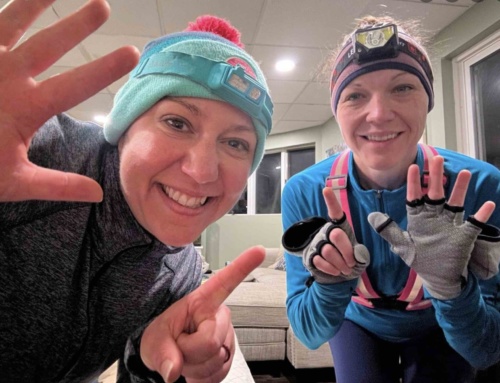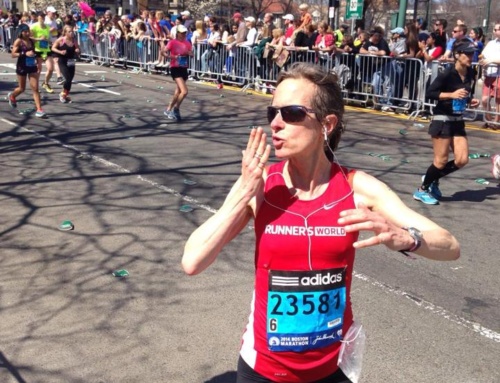Written by Hailey Middlebrook; originally published in Runner’s World on 1/10/19
With a 50K trail run, triathlons, and a 166-mile relay in the books, Deanna Tysdal credits going long for keeping her symptoms at bay.
It started with her thumb. In 2005, Deanna Tysdal’s finger went numb when she was playing volleyball with her friends in Kansas City, Kansas. She shook off the sensation and finished the game, thinking she must have hit the ball funny.
Then the next week, her pointer finger went numb. Then her whole hand lost feeling.
“I knew what was happening,” Tysdal, who’s 41, told Runner’s World. “Because the same thing happened to my brother seven years earlier.”
When Tysdal was 14, her 19-year-old brother, Eric, was diagnosed with multiple sclerosis (MS), a disease that attacks the central nervous system and causes a host of symptoms, including severely impaired muscle movement. At the time of his diagnosis, Eric had just started college.
“I had always looked up to him, because he was so smart and athletic,” Tysdal said. “But the disease took over.”
The progression of Eric’s MS was painful for Tysdal to watch. She remembers him losing function of his legs, then having to scoot, seated, up the stairs, using his arms to pull himself up. By age 25, he was wheelchair-bound. In the years that followed, he had difficulty speaking, and eventually was forced to use a feeding tube and catheter. His devastating situation was a big reason Tysdal left her hometown of Omaha, Nebraska, to move to Kansas City after college.
“I needed to distance myself from it,” she said.
But when she experienced the numbness in her hand a few years later, her head flashed with visions of herself in the same situation. She went to see the doctor, who first thought she was just experiencing carpal tunnel syndrome. But after that test turned out negative, she underwent a spinal tap, which confirmed her suspicions: She had MS.
While the disease has no cure, she was prescribed medicine to keep her symptoms—including muscle pain, fatigue, and dizziness—at bay. Her doctors warned her that MS was an unpredictable illness, and loss of muscle function could be sudden.
“My legs could be working one day, then they could stop working the next,” she said. “I decided then and there that as long as they are working, I’m going to use them.”
Around that time, Tysdal moved to Huntington Beach, California, where she worked in hospitality. The fresh air and easy-going nature of the surf town was good for her, she said, as it took her mind off her diagnosis.
But the MS symptoms persisted: her balance worsened, she suffered nerve pain, and parts of her body would sporadically go numb. Having competed in ball sports since she was little, she tried to continue playing pickup games of volleyball and softball, but her skills were declining.
In one particularly alarming game of softball, she attempted to run to first base, but her legs lost feeling in them. She collapsed halfway there.
“It was probably a funny thing to watch, but I was freaking out,” she said. “It’s scary to think that my legs won’t move again.”
Thankfully, her legs recovered, but the scare sparked Tysdal to find a way to stay active in spite of the uncertain disease. Her roommate at the time was training for a race, and though Tysdal had never really liked running, she figured tagging along would keep her body strong and healthy. Plus, she said, she didn’t know how long she could run.
Before she started running, she asked her doctor what he thought. “He said that he didn’t know how I would do it, but if I could, then I should,” she said. “As long as I’m careful and not in pain while I’m running, he said there’s no reason I shouldn’t try.”
In fact, research has found that regular moderate exercise boosts aerobic fitness and muscular strength in people with mild to moderate MS-related disabilities, which may help lessen their fatigue and improve their mobility and quality of life.
Tysdal began running a few miles twice a week with her roommate, and once she got used to the distance, she worked up to four days of running a week. When her roommate was busy, she went alone, often running along the boardwalk. The miles by the sea cleared her mind and gave her a confidence boost. With each step she took, she was bucking MS.
“I thought of it as positive karma,” she said. “As long as I used my body, it wouldn’t fail me.”
As the years passed, Tysdal continued to tack on more miles to her daily runs. She finished eight half marathons, 10 triathlons, a 50K trail run, a full marathon, and in 2017, a six-day, 166-mile run from Vernal, Utah, to Steamboat Springs, Colorado, as part of MS Run the U.S., an annual relay race supporting research for the disease.
To train for the ultramarathon, Tysdal kept her weekly mileage between 60 and 80, doing back-to-back long runs of 25 and 20 miles on Saturday and Sunday, respectively, to practice running on tired legs.
“I learned pretty quickly that I shouldn’t try to push the pace, just cover the distance,” she said. “That way, I don’t get hurt. Even if I’m running 13 or 14 minute miles, I’m still moving.”
The longer she runs, she explained, the less severe her MS symptoms are. If she skips a run, she feels more fatigued, less steady on her feet, and suffers worse nerve pain. That said, she has to be cautious every time she laces up her trainers, since the disease affects her sense of balance and touch.
“I have to be extremely careful when running on trails with a lot of roots and rocks, because I lose my balance so easily,” said Tysdal, who is now back in her hometown of Omaha with her husband and their 5-year-old daughter and 7-year-old son. “I only run on flat, paved surfaces that are well-lit.”
Like many others with MS, Tysdal is sensitive to shifts in temperature—particularly heat. When it’s hot out, “my whole body goes numb,” she said. Though the numbness doesn’t prohibit her from finishing her run, it slows her reaction time and makes it difficult for her to feel any injuries coming on. To be safe, she always runs with a location tracker activated on her phone, so her husband knows where she is.
This spring, she’s planning to participate in MS Run the U.S. again, splitting the 135-mile stretch from Milford, Utah, to Nephi, Utah with a friend. She hopes to raise$15,000 for MS research during the event. But perhaps more importantly, she hopes that others—both those suffering from the disease and not—will follow in her footsteps.
“I hate when people say, ‘Oh, I can’t run,’ when they can,” she said. “Because there might be a day when you really can’t run. I know I have MS, but I’m not done yet.”







You are an inspiration! I’m a fellow runner with MS who also started running after diagnosis and I also credit running with helping me “fight” the effects of the disease. I hope you continue to feel well and pile up those miles!!!
Inspiring! Deanna, you’re a stunning example of BAMR spirit and an encouragement to tackle Big Stuff. To your continued health and long distance adventures!
This is very encouraging! I have some nerve damage in my feet from chemo several years ago. It has stopped me from running in humid weather. Your story challenges me to try again. God bless you!
as another mother runner with ms i thank you for sharing your experience. i cannot agree more with the concept that movement is healthy for everyone, especially people with ms. we move to our ability modifying wisely when needed. im getting better and knowing when to slow down but it remains a struggle in my “never gonna quit” stubborn heart. i have my sights on a 50 k next year….i like the mantra that I may have MS but MS doesnt have me! thanks again for your story of encouragement!
Great article, Deanna!! #orangearmy